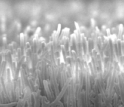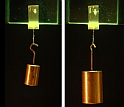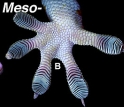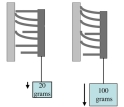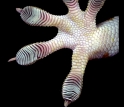News Release 08-013
The Pitter Patter of Little Feet . . . Climbing Straight Up a Wall
New adhesive is first to mimic quick catch and rapid release traits of a gecko's foot
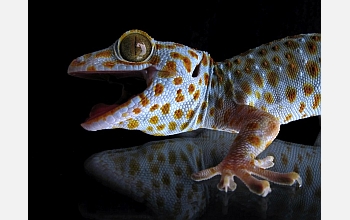
A gecko sits atop a glass surface in this image from the NIRT laboratory.
January 29, 2008
This material is available primarily for archival purposes. Telephone numbers or other contact information may be out of date; please see current contact information at media contacts.
Building upon several years of research into the gecko's uncanny ability to climb sheer walls, researchers at the University of California, Berkeley, have developed an adhesive that is the first to master the easy attach and easy release of the reptile's padded feet. The material could prove useful for a range of products, from climbing equipment to medical devices.
Unlike duct tape or glue, the new material is crafted from millions of tiny, hard, plastic fibers that establish grip; a mere square two centimeters on a side can support 400 grams (close to a pound). While tape sticks when it presses onto a surface, the new adhesive sticks as it slides on a surface and releases as it lifts -- this is the trick behind a gecko's speedy vertical escapes.
The new study appeared online Jan. 23, 2008, in the Journal of the Royal Society Interface.
There are other synthetic adhesives inspired by gecko feet and they adhere much like conventional tape. In contrast, the new adhesive brushes along a surface to develop traction. While ideal for hanging posters, the characteristic is even more important for any application that requires movement, such as climbing.
"The gecko has a very sophisticated hierarchical structure of compliant toes, microfibers, nanofibers and nanoattachment plates that allows the foot to attach and release with very little effort," said co-author and Berkeley professor Ron Fearing, "The gecko makes it look simple, but the animal needs to control the directions it is moving its toes--correct movement equates to little effort," he said.
The new material is also novel in that it gets stronger with use. In experiments, it tightened its hold as it was rubbed repeatedly against a glass plate. The extra strength is caused by the fibers bending over to make more contact, yet once released, the fibers returned to their original shape. The research team is exploring ways to permanently bend the fibers so that the grip strength is its strongest from the outset, no massaging required.
According to Fearing, the new material is the first to mimic the nature of the gecko's characteristic "non-sticky by default" feet. The Berkeley researchers, all engineers, have worked closely with biologists Robert Full, also at Berkeley, and Kellar Autumn of Lewis and Clark College in Portland, Ore., to uncover the key natural properties behind that unique foot, the secret to high mobility on sheer surfaces.
Fearing and his colleagues are part of an NSF-supported Nanoscale Interdisciplinary Research Team (NIRT) that was specifically tasked in 2003 with developing biologically-inspired synthetic gecko adhesives.
"The results of this project are an impressive example of how teaming engineers with biologists results in a better understanding of the role of 'engineering' in nature," says Lynn Preston, the NSF officer who supported these NIRT researchers, and many other teams of engineers and biologists, through her leadership of NSF's Engineering Research Centers program. "This is a perfect example of how to turn that understanding into products that are as sophisticated as those developed by 'Mother Nature'."
Additional details about the research are available at:
Smart Gecko Tape: http://robotics.eecs.berkeley.edu/~ronf/Gecko/interface08.html
-NSF-
-
The new microfibers researchers developed to mimic the gecko's foot pads.
Credit and Larger Version -
The gecko-inspired adhesive can support significant weight.
Credit and Larger Version -
This collage illustrates gecko adhesion, from toes to nanostructures.
Credit and Larger Version -
Conceptual drawing illustrating how the new material functions.
Credit and Larger Version -
A close-up view of a tokay gecko's foot.
Credit and Larger Version
Media Contacts
Joshua A. Chamot, NSF, (703) 292-7730, email: jchamot@nsf.gov
Sarah Yang, University of California, Berkeley, (510) 643-7741, email: scyang@berkeley.edu
Program Contacts
Lynn Preston, NSF, (703) 292-5358, email: lpreston@nsf.gov
Principal Investigators
Ronald Fearing, University of California, Berkeley, (510) 642-9193, email: ronf@eecs.berkeley.edu
The U.S. National Science Foundation propels the nation forward by advancing fundamental research in all fields of science and engineering. NSF supports research and people by providing facilities, instruments and funding to support their ingenuity and sustain the U.S. as a global leader in research and innovation. With a fiscal year 2023 budget of $9.5 billion, NSF funds reach all 50 states through grants to nearly 2,000 colleges, universities and institutions. Each year, NSF receives more than 40,000 competitive proposals and makes about 11,000 new awards. Those awards include support for cooperative research with industry, Arctic and Antarctic research and operations, and U.S. participation in international scientific efforts.
Connect with us online
NSF website: nsf.gov
NSF News: nsf.gov/news
For News Media: nsf.gov/news/newsroom
Statistics: nsf.gov/statistics/
Awards database: nsf.gov/awardsearch/
Follow us on social
Twitter: twitter.com/NSF
Facebook: facebook.com/US.NSF
Instagram: instagram.com/nsfgov



